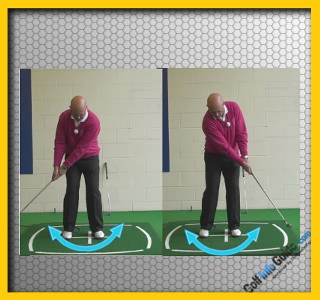Top 3 Tips on Putting Stroke Mechanics
Putting is perceived as the easiest part of golf to learn, but remains the toughest to master. This is true because most golfers don’t practice their putting as often as they should. Time on the practice green should double or triple any time spent practicing on the driving range. If you spend three hours a week working on your long game, you’ll need a minimum of six hours working on your short game.
The numbers referring to time may be a little frightening, but if you wish to dramatically improve your putting and have consistently lower scores, that’s the dedication required. However, when it comes to the greens a perfect putting stroke is not required. Over time, the best and most consistent putters rarely have the prettiest technique.
Putting is an art form that requires great touch, tempo and a positive attitude. If you can master these three skills, you’ll become a considerably better putter.

Touch, otherwise known as distance control is a vital aspect to becoming a well-rounded putter. Great touch means that you will always be in control of your distance and believe it or not, that will make the hole bigger. If the ball has ideal distance control it has more chance of hitting the hole and falling in. If it’s approaching the hole with too much speed it will most likely hit the hole and lip out. Perfect distance control is achieved when a ball stops no more than eight inches past the hole.
In order to achieve perfect touch, the best drill is to find a relatively flat area of the putting green. Find the straightest putt and set up three locations to putt from. First location will be six feet away (approximately 1 step is equal to 3 feet) and put a tee in the ground. Second location will be fifteen feet away while the third location will be thirty feet away. Next you will place one tee approximately eight inches behind the hole. If you have chalk or string, it may be advantageous to make an eight inch semi-circle from the front of the hole around to the tee.
You will then take three golf balls and putt them from the first location. Success in this drill is rated by getting 2 out of 3 balls to stop between the front of the hole and the tee eight inches behind the hole. This drill is about distance control and not so much about the line. Therefore, if a ball finishes a foot left or right of the hole but within the parameters, it’s still a success. Once you have success at the first location move on to the second etc.
This drill is very simple, but if done as part of your practice and pre-game warm up you will see less three putts and many shorter putts find the bottom of the hole.

All great putters share a very common trait of putting. Perfect tempo. Some putt with a long and slow tempo to their stroke, while others putt with a short quick tempo. The end result is the speed of their stroke generally coincides with their personality.
2 time Masters Champion Ben Crenshaw was known for his impeccable tempo while putting. He displayed a long slow rhythm to his putting stroke. Crenshaw’s nick name was “Gentle Ben” because he was such a laid back and quiet individual. His smooth putting stroke was just a reflection of who he was.
Major winner Nick Price had a much faster rhythm to his putting stroke. Price walked quickly, talked quickly and swung the club quickly. Again, his putting stroke was just a bi-product of who he was as a person.
Developing great rhythm and tempo in your putting stroke begins by understanding your own personal traits. If you’re an outgoing individual who likes to get things done quickly, you should be putting with a short quick stroke. If you’re a relaxed person by nature, then a longer smooth stroke will be best for you.
Finally, always remember that great tempo in a putting stroke should have no significant increase or decrease of speed and definitely no pausing or stopping.

Tip #3 Develop a Positive Attitude
Most golfers think terribly of themselves on the golf course, and are defeated before they even tee it up on the first hole. But those that putt consistently well, believe they will make every putt they are faced with on the green. It’s like a quiet confidence that only they can feel. They see their ball going in the hole before they even putt it.
Developing a positive outlook on the greens really comes from good practice and playing lots of golf without focusing on the negative outcomes. Every time you step on a green tell yourself “I’m making this one” and believe it. Don’t focus on the putts you’ve missed but rather focus on making the one directly in front of you.






